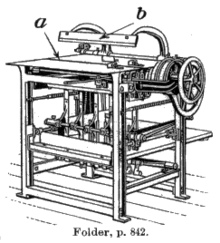Folding machine
A folding machine is a machine used primarily for the folding of paper. Paper can be folded with either a buckle or a knife; thus, there are generally three types of folding machines: buckle folders, knife folders or a combination of these two types. Whilst buckle folding is the more popular of the two methods, knife folding is sometimes preferable. Folding machine models vary in sophistication, with high-end machines capable of processing more complex folding jobs and unusual paper forms (in terms of density and size).[1] Organizations required to undertake mass mail-out campaigns often employ folding machines to improve efficiency.[1]

.jpg)
Buckle folders
Buckle folders work by feeding the paper at high speeds until it can move no further; the reaction of the paper is to buckle. High friction rollers then grip the paper and push it through, folding the paper, which is squeezed between the rollers, in the process. Attached rubber provides the rollers with the required grip. The front edge of the paper is then finally placed into a "pocket"—a result of the rollers pressing together with the aid of a spring.
Knife folders
A knife folder works by striking the paper with a knife between two rollers. This knife is not sharp enough to cut through the paper and simply strikes and creases the paper along the line where the fold is required. Ideally, knife folding is used with thick paper, for "cross folds" (commonly employed for maps and also known as a "French fold")[2] or if the paper has been stitched during the folding process; stitched sheets can ruin high friction rollers.
Paper folders
Folding machines exclusively used for folding paper are commonly referred to as paper folders. These machines are typically used for creating letter folds (C Folds) and accordion folds (Z Folds). Other commonly used folds include a half fold, fold-out, double parallel fold, gate (brochure) fold, and right angle fold.
The fold type in a buckle folder is set by adjusting folding plates. Most paper folders allow for a wide range of fold types. Right angle folds require the paper to rotate 90 degrees also known as an 8-page or a right angle. More folds can be accomplished by the use of a 16-page and 32-page unit.
Entry-level paper folders require that the folding plates be adjusted manually, with fold settings specified on the folding plates. Higher-end paper folders will electronically adjust the folding plates for added precision and convenience. Both usually have fine tuning knobs for precise adjustments.
Most paper folders push paper into the machine by use of a friction wheel; this grabs paper using friction. Friction-feed paper folders do not work well with glossy paper as the friction wheel slips on the paper's surface. Pneumatic paper folders are preferable for folding glossy paper.[3]
Pneumatic folding machines
Pneumatic paper folders push paper into the machine using a vacuum. These folders are often referred to as air-powered paper folders. This method makes it possible to fold most types of paper. Most pneumatic paper folders include a built-in compressor. These folders can have as many as sixteen folding plates or several knife folds depending on the imposition, these are adjusted manually or electronically, depending on the machine.
Feeding systems
There are 2 types of feeding systems used by folders, pile and continuous. The first is flat pile, in which the paper is placed on a feeding table and each sheet is then transported into the machine by friction or an air-controlled suction-wheel. A variation of this is palletized feeding, in which an entire pallet full of paper may be placed on the feeding table. The second type is called "continuous"; this involves the sheets being placed onto a belt, on a table or rollers, that takes it around the end of the machine, then each sheet is individually pushed into the machine by an air-controlled suction-wheel. The sheets of paper will be separated by blowing air between them.
Folder inserters
Folder inserters are designed for mailing bills, checks and other material. Folder inserters take paper, fold it, insert it into an envelope and seal the envelope. Folder inserters are available in several designs, many equipped with multiple feed trays for several sheets of paper. Many have the ability to include inserts and return envelopes. These are mixtures of knife and buckle folders.[4]
Folder sealers
Paper folder sealers are used to fold special pressure-sensitive paper. As the paper is folded, pressure rollers roll along the edge of the paper, bursting open tiny glue pockets that seal the letter shut. Pressure sealed documents are typically opened by tearing off a perforated side or tearing open the sealed portion of the letter. Documents that have been folded and sealed do not require an envelope for mailing and are often used for mailing bills, invoices and other mailed documents.
See also
References
- "What is a Letter Folding Machine?". WiseGeek — Clear answers for common questions. Conjecture Corporation. 2003–2012. Retrieved 29 April 2012.
- "What Is A Cross Fold / French Fold?". abcoffice.com – "When you need more than staples". American Binding Company, Inc. 28 September 2010. Retrieved 29 April 2012.
- "Paper Folder Resources Guide". Retrieved 21 August 2009.
- "Folder Inserter FAQ". Retrieved 21 August 2009.
